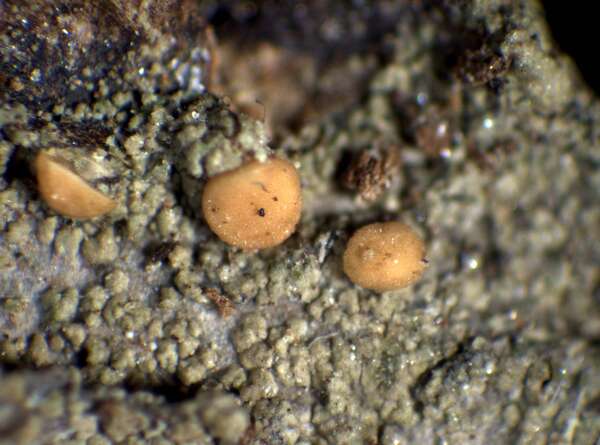Bacidia punica Llop
Bryologist, 113: 366, 2010.
Synonyms:
Distribution: C - Tosc (Llop 2010), Marc (Llop 2010), Laz (Llop 2010), Sar (Llop 2010). S - Bas (Llop 2010), Pugl (Llop 2010), Si (Llop 2010).
Description: Thallus crustose, greyish green, continuous to rimose-areolate, with a granulose surface. Cortex colourless, paraplectenchymatous, 10-20 μm thick; algal layer continuous. Apothecia yellow-orange to pink-orange, more rarely pale cream to translucent, (0.15-)0.2-0.5(-0.65) mm across, with a flat to convex disc and a weakly prominent, slightly paler, shiny proper margin. Proper exciple colourless to pale yellow, prosoplectenchymatous, with a dense textura intricata, 25-30 μm thick, of radiating, branched and anastomosing hyphae, the lumina 4-10(-12) x 1-1.5(-2) μm thick, the terminal cells slightly obovate to globose, (2-)2.5-5.0 μm wide; epithecium not differentiated from hymenium; hymenium colourless, (40-)45-60(-65) μm high; paraphyses coherent, simple, not anastomosing, 1-1.5 μm thick at mid-level, the apical cells 1.5-3.5(-4.0) μm wide; hypothecium colourless to pale yellow, prosoplectenchymatous, c. 30 μm high, with a loose textura intricata; subhymenium colourless to pale yellow, paraplectenchymatous, 10-15 μm thick, with textura globularis. Asci 8-spored, clavate to cylindrical-clavate, the apical dome K/I+ dark blue with a pale, conical-pointed apical cushion (axial mass), the wall K/I-, but the thin outer gel K/I+ blue, Bacidia-type. Ascospores 3-7-septate, hyaline, needle-like, tapering to one end, (24-)28-40(-42) x (1-)1.5-2 μm. Pycnidia rare, colourless, immersed in the thallus, 50–70 µm wide. Conidia (original description) filiform, straight, 5-10-septate, (40-)45-60 x c. 1 μm, according to Ekman (2023) strongly curved, aseptate, 7-14 x 1-1.2 µm, with tapering ends, formed terminally on ampulliform, 6–8 µm long and c. 2 µm wide conidiogenous cells. Photobiont chlorococcoid. Spot tests: thallus K-, C-, KC-, P-, UV-. Chemistry: thallus without lichen substances; pigmented parts of apothecia with small amounts of the Rubella-orange pigment.Note: an epiphytic species, widespread but not common in Tyrrhenian Italy, mostly in shaded-humid situations, with optimum within eu-Mediterranean vegetation.
Growth form: Crustose
Substrata: bark
Photobiont: green algae other than Trentepohlia
Reproductive strategy: mainly sexual
Commonnes-rarity: (info)
Alpine belt: absent
Subalpine belt: absent
Oromediterranean belt: absent
Montane belt: absent
Submediterranean belt: extremely rare
Padanian area: absent
Humid submediterranean belt: very rare
Humid mediterranean belt: very rare
Dry mediterranean belt: extremely rare

Predictive model
Herbarium samples
Growth form: Crustose
Substrata: bark
Photobiont: green algae other than Trentepohlia
Reproductive strategy: mainly sexual
Commonnes-rarity: (info)
Alpine belt: absent
Subalpine belt: absent
Oromediterranean belt: absent
Montane belt: absent
Submediterranean belt: extremely rare
Padanian area: absent
Humid submediterranean belt: very rare
Humid mediterranean belt: very rare
Dry mediterranean belt: extremely rare

Predictive model
| Herbarium samples |
 INDEX FUNGORUM
INDEX FUNGORUM
 GBIF
GBIF



